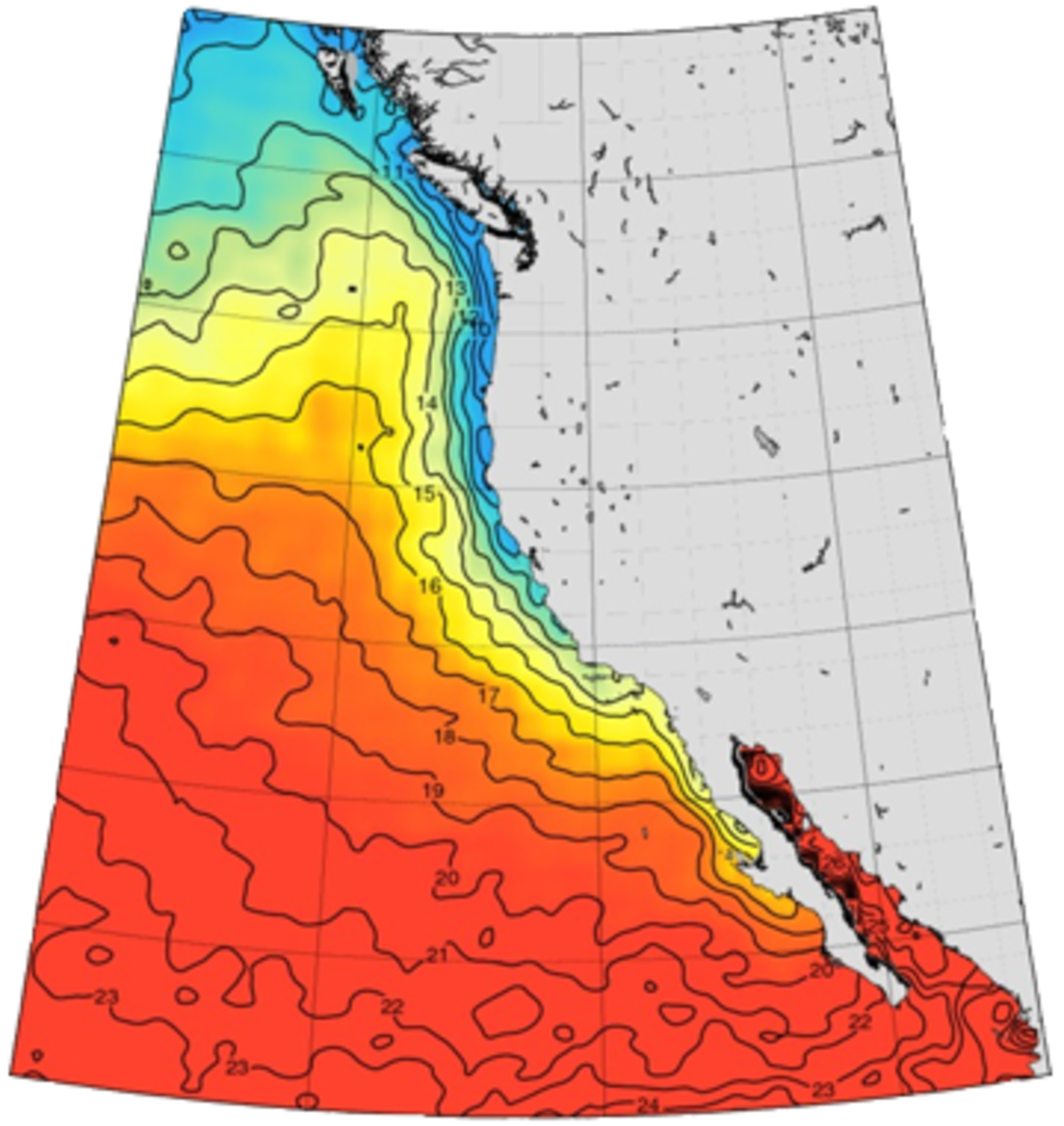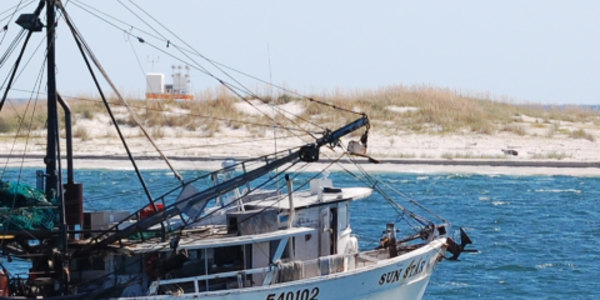The Northeast Pacific (NEP) is one of the most productive ecosystems in the World Ocean, home to the California Current System (CCS) and a large coastal upwelling zone along the west coast of North America. The economic and climatic importance of the CCS has prompted intensive observation and research over the decades, yielding rich oceanographic data arrays of the area and its adjacent regions.

These decadal climatologies were generated from regional data in the World Ocean Database (WOD) collected from 1955 to 2012. The description of datasets used can be found in WOD 2013.
Citation
Seidov, D.; Baranova, O.K.; Boyer, T.P.; Cross, S.L.; Mishonov, A.V.; Parsons, A.R. (2017). Northeast Pacific Regional Climatology (NCEI Accession 0163799). [indicate subset used]. NOAA National Centers for Environmental Information. Dataset. doi:10.7289/V5NC5ZDN
Description
The Northeast Pacific (NEP) is one of the most productive ecosystems in the World Ocean, home to the California Current System (CCS) and a large coastal upwelling zone along the west coast of North America. The economic and climatic importance of the CCS has prompted intensive observation and research over the decades, yielding rich oceanographic data arrays of the area and its adjacent regions.
Parameters
A set of analyzed temperature and salinity fields were computed for the NEP domain to assess long-term climatological tendencies in this important region of the Pacific Ocean. The set is comprised of objectively analyzed temperature and salinity fields, and additional parameters including:
- Simple statistical means
- Data distributions
- Standard deviations
- Standard errors of the mean
- Observed minus analyzed
- Seasonal minus annual distributions for both temperature and salinity
These parameters were computed using all data in the 2013 release of the WOD.
Analysis Methods
Seasonal and annual fields are based on complete monthly analyses of all three horizontal grids (1°x1°, a 1/4°x1/4°, and 1/10°x1/10°), which are computed by averaging six decadal monthly analyses from 1955 to 2012. Seasonal fields at all depths above 1500 meters are computed from the average of the three months comprising each season (e.g., January, February and March for winter), while annual mean fields are computed by averaging the four seasonal fields at all depths. The annual analysis of measurements below 1500 meters is the mean of the four seasonal analyses, and only shows annual and seasonal fields (the monthly fields are not shown).
Using High Resolution Fields
The high-resolution monthly temperature and salinity data coverage on the 1/10°x1/10° grid have more gaps than seasonal and annual fields computed from the monthly fields. In general, all high-resolution analyzed fields should be reviewed carefully before using them in critical mission applications, particularly high-resolution monthly fields. Users should review the data distribution and statistical mean arrays before deciding whether to use the high-resolution analyzed temperature and salinity fields or their climatological means. Moreover, the monthly maps of objectively analyzed data on 1/10°x1/10° may show too strong eddy-like irregularities in some regions due to interpolation and plotting combined. Although such cases are very few, it’s important to carefully review fields with such occurrences is needed before using analyzed variables in research or applications.
Temperature and Salinity
Temperature and salinity climatologies are calculated separately, because there are significantly more temperature data than salinity data. Because of this disparity, there are not always concurrent temperature and salinity measurements.
As a result, instabilities in the vertical density field can occur when density is calculated from standard level climatologies of temperature and salinity. Appendices A and B in (Locarniniet al., 2013) describe a method employed to stabilize the water column anywhere in the world ocean by minimally altering climatological temperature and salinity profiles. All analyses shown in the NWA regional climatology have been performed using this stabilizing method.
Area
NEP domain: 140.0°W 106.0°W—20.0°N and 55.0°N
Temporal Resolution
All data from the WOD13 for the NEP domain were used to calculate six decadal climatologies within the following time periods: 1955-1964; 1965-1974; 1975-1984; 1985-1994; 1995-2004; 2005-2012. The all averaged decadal climatology was calculated by averaging six individual decades listed above (see World Ocean Database 2013 Introduction).
Each decadal climatology consists of:
- Annual Fields
- Computed as 12-month averages
- Seasonal Fields
- Winter (Jan.-Mar.), Spring (Apr.-Jun.), Summer (Jul.-Sep.), Fall (Oct.-Dec.) computed as 3-month averages
- Monthly Fields Above 1500 m
- Monthly fields are shown only on the 1°x1° and 1/4°x1/4° latitude/longitude grids
Spatial Resolution
- Annual and Seasonal Fields
- 1°x1°, 1/4°x1/4°, and 1/10°x1/10° latitude/longitude grids
- Monthly Fields
- 1°x1° and 1/4°x1/4° grids only
Vertical Resolution
- Annual and Seasonal Fields
- 0 to 5500 m depth on 102 standard levels
- Monthly Fields
- 0 to 1500 m on 57 standard levels
Standard depth levels in the NEP regional climatology are the same as in the WOA13 (see Table 3 in the WOA13 documentation).
Objectives
Higher spatial resolutions – here the 1/10°x1/10° grid – provide major advantages in the areas where such resolutions are feasible and supported by data availability. The quality control on a higher-resolution grid reveals more outliers than an analysis on coarser grids. More importantly, with the significantly shorter radius of influence in the objective analysis procedure, the structure of the gridded fields is far better sustained, especially in regions with sharp gradients of the essential oceanographic parameter (temperature and salinity). Residual effect of quasi-stationary meanders and transient mesoscale eddies on climatological fields is clearly seen at 1/10°x1/10° resolution. They are better preserved in high-resolution climatological fields, which make them more valuable for ocean modeling and other applications.
Units
- Temperature
- °C
- Salinity
- Unitless on the Practical Salinity Scale-1978
Bathymetry
For all three grid resolutions, mean depth values at the center of a grid square with the respective resolution were extracted from the ETOPO2 World Ocean bathymetry.
Method
The methods for calculating mean climatological fields are described in Temperature: Locarnini et al., 2013, Salinity: Zweng et al., 2013. Additional details on high-resolution climatological calculations can be found in Boyer et al., 2005. The updated table provides radii of influence for the analysis procedure as:
| Pass | 1° radius of influence | 1/4° radius of influence | 1/10° radius of influence |
|---|---|---|---|
| 1 | 892 km | 321 km | 253 km |
| 2 | 669 km | 267 km | 198 km |
| 3 | 446 km | 214 km | 154 km |
Most of the procedures used for generating the NWA, Arctic (Boyer et al., 2012) and GINS (Seidov et al., 2013) regional climatologies are similar. A pilot study using the Arctic Regional Climatology was published in a special issue of the Progress in Oceanography (Seidov et al., 2015).
Related Publications
- Boyer, T., S. Levitus, H. Garcia, R.A. Locarnini, C. Stephens, J. Antonov, 2005: Objective analyses of annual, seasonal, and monthly temperature and salinity for the world ocean on a 0.25 degree grid. International Journal of Climatology, 25(7), 931-945.
- Boyer, T.P., J.I. Antonov, O.K. Baranova, C. Coleman, H.E. Garcia, A. Grodsky, D.R. Johnson, R.A. Locarnini, A.V. Mishonov, T.D. O'Brien, C.R. Paver, J.R. Reagan, D. Seidov, I.V. Smolyar, M.M. Zweng, 2013: World Ocean Database 2013. Sydney Levitus, Ed.; Alexey Mishonov, Technical Ed.; NOAA Atlas NESDIS 72, 209 pp. doi:10.7289/V5NZ85MT.
- Boyer, T.P., O.K. Baranova, M. Biddle, D.R. Johnson, A.V. Mishonov, C. Paver, D. Seidov and M. Zweng (2015), Arctic Ocean Regional Climatology (NCEI Accession 0115771). [indicate subset used]. NOAA National Centers for Environmental Information. Dataset. doi:10.7289/V5QC01J0.
- Levitus, S., 1982: Climatological Atlas of the World Ocean. NOAA Professional Paper 13, 173 pp., U.S. Gov. Printing Office, Rockville, MD. ftp://ftp.library.noaa.gov/noaa_documents.lib/NOAA_professional_paper/NOAA_paper_13.pdf
- Locarnini, R.A., A.V. Mishonov, J.I. Antonov, T.P. Boyer, H.E. Garcia, O.K. Baranova, M.M. Zweng, C.R. Paver, J.R. Reagan, D.R. Johnson, M. Hamilton, and D. Seidov, 2013: World Ocean Atlas 2013, Volume 1: Temperature. S. Levitus, Ed., A. Mishonov Technical Ed.; NOAA Atlas NESDIS 73, 40 pp. doi:10.7289/V55X26VD.
- Seidov, Dan; Baranova, Olga K.; Biddle, Mathew; Boyer, Timothy P.; Johnson, Daphne R.; Mishonov, Alexey V.; Paver, Christopher; Zweng, Melissa (2013). Greenland-Iceland-Norwegian Seas Regional Climatology (NCEI Accession 0112824). [indicate subset used]. NOAA National Centers for Environmental Information. Dataset. doi: 10.7289/V5GT5K30.
- Seidov, D., J.I. Antonov, K.M. Arzayus, O.K. Baranova, M. Biddle, T.P. Boyer, D.R. Johnson, A.V. Mishonov, C. Paver and M.M. Zweng, 2015: Oceanography north of 60°N from World Ocean Database, Progress in Oceanography, 132, 153-173, doi:10.1016/j.pocean.2014.02.003.
- Zweng, M.M, J.R. Reagan, J.I. Antonov, R.A. Locarnini, A.V. Mishonov, T.P. Boyer, H.E. Garcia, O.K. Baranova, D.R. Johnson, D.Seidov, M.M. Biddle, 2013: World Ocean Atlas 2013, Volume 2: Salinity. S. Levitus, Ed., A. Mishonov, Technical Ed.; NOAA Atlas NESDIS 74, 39 pp. doi:10.7289/V5251G4D.



